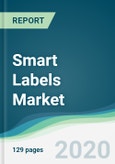The global smart labels market is projected to grow at a CAGR of 10.09% to reach US$9,795.594 million by 2025, from US$5,501.481 million in 2019. A smart label is an identification slip, other than a barcode, installed on the products’ package that incorporates advance features like QR Codes, electronic article surveillance, among others, to provide product-related information to the customers. Smart labels come with the advantage of preventing theft or counterfeiting of products and enables the real-time tracking of the product from the warehouse to the distribution center. Hence, the retailer can manage inventory levels at low-cost. They also improve operational efficiency and aid in better marketing of the products by analyzing consumer buying behavior. A rising number of digitally literate people across developing countries is expected to act as a catalyst in the rise of this market. The strict regulations by the governments with respect to the product information to be labeled on the product itself are expected to fuel the demand for smart labels even more.
Rapid technological advancement and rising digitally literate and tech-savvy populations are major demand drivers of the market.
Big Data, Internet of Things (IoT), digital printing innovations are some of the illustrations of technological upgradations that are leading the growth of the smart print labels market. The technology provides access and security to the products remotely. Rising sales of electronic goods and growing awareness regarding consumer rights is a major reason for the success of this market. Consumers tend to receive product-related information on an app in their handsets. E-commerce giants such as Amazon, and retail stores like Walmart, are employing smart labels to manage their supply chains and logistics.
Mergers and Acquisitions are also taking place in this market to help companies remain competitive in the rising demand scenario. For instance, in 2019, Avery Dennison acquired an RFID (Radio-frequency identification) Division of Smartrac to supplement its smart tags or labels product portfolio. Vice President of Avert Dennison, Francisco Melo, said, “We believe in a future where every physical item will have a unique digital identity and digital life, which will transform the visibility of products throughout the supply chain, all the way to the consumer, helping to improve efficiencies, increase sustainability, and enhance consumer experience,”
Geographically, Asia Pacific is expected to grow rapidly due to the increasing investment by major retail players
Asia-Pacific region is expected to grow at a high CAGR throughout the forecast period owing to the rising sales of packaged food items. Growing FMCG and Healthcare sectors in this region are also expected to boost the sales of smart labels. Also, smart labels can monitor the temperature of the product and alarm off the seller if a threat is detected. This is fueling the market for smart labels in developed and developing economies to reduce wastage of resources.
Segmentation:
By Technology
By End-user Industry
By Geography
North America
Europe
The Middle East and Africa
Asia Pacific
Rapid technological advancement and rising digitally literate and tech-savvy populations are major demand drivers of the market.
Big Data, Internet of Things (IoT), digital printing innovations are some of the illustrations of technological upgradations that are leading the growth of the smart print labels market. The technology provides access and security to the products remotely. Rising sales of electronic goods and growing awareness regarding consumer rights is a major reason for the success of this market. Consumers tend to receive product-related information on an app in their handsets. E-commerce giants such as Amazon, and retail stores like Walmart, are employing smart labels to manage their supply chains and logistics.
Mergers and Acquisitions are also taking place in this market to help companies remain competitive in the rising demand scenario. For instance, in 2019, Avery Dennison acquired an RFID (Radio-frequency identification) Division of Smartrac to supplement its smart tags or labels product portfolio. Vice President of Avert Dennison, Francisco Melo, said, “We believe in a future where every physical item will have a unique digital identity and digital life, which will transform the visibility of products throughout the supply chain, all the way to the consumer, helping to improve efficiencies, increase sustainability, and enhance consumer experience,”
Geographically, Asia Pacific is expected to grow rapidly due to the increasing investment by major retail players
Asia-Pacific region is expected to grow at a high CAGR throughout the forecast period owing to the rising sales of packaged food items. Growing FMCG and Healthcare sectors in this region are also expected to boost the sales of smart labels. Also, smart labels can monitor the temperature of the product and alarm off the seller if a threat is detected. This is fueling the market for smart labels in developed and developing economies to reduce wastage of resources.
Segmentation:
By Technology
- Electronic Article Surveillance (EAS)
- RFID
- Sensing Label
- NFC
- Electronic Shelf Label (ESL)
By End-user Industry
- Healthcare
- FMCG
- Transport and Logistics
- Manufacturing
- Retail
- Others
By Geography
North America
- USA
- Canada
- Mexico
- South America
- Brazil
- Argentina
- Others
Europe
- UK
- Germany
- France
- Others
The Middle East and Africa
- Saudi Arabia
- UAE
- Israel
- Others
Asia Pacific
- Japan
- China
- India
- Others
Table of Contents
1. Introduction
2. Research Methodology
3. Executive Summary
4. Market Dynamics
5. Global Smart Labels Market Analysis, by Technology
6. Global Smart Labels Market Analysis, by End-user Industry
7. Global Smart Labels Market Analysis, by Geography
8. Competitive Environment and Analysis
9. Company Profiles
Companies Mentioned
- Avery Dennison Corporation
- CCL Industries Inc.
- Zebra Technologies Corporation
- Smartrac N.V.
- Alien Technology
- SATO Holdings Co., Ltd.
- Muehlbauer Holding AG
- Invengo Information Technology
- Thin Film Electronics
- Checkpoints Systems Inc.
Methodology

LOADING...








